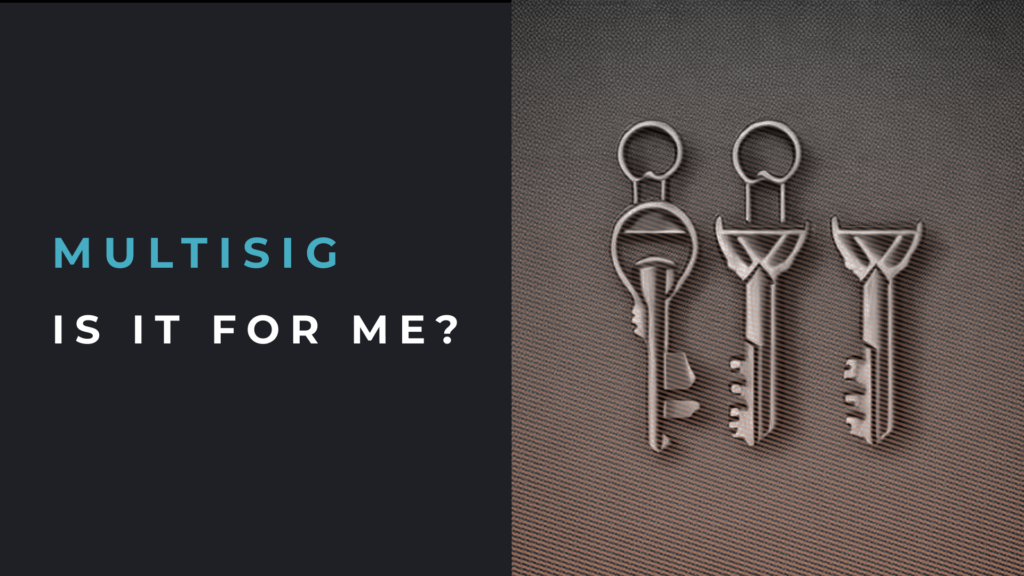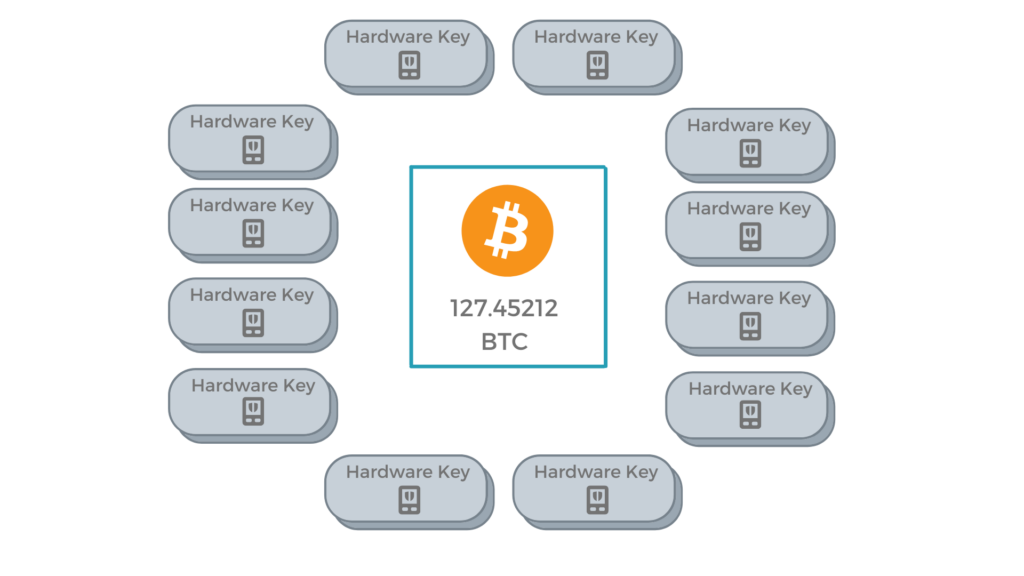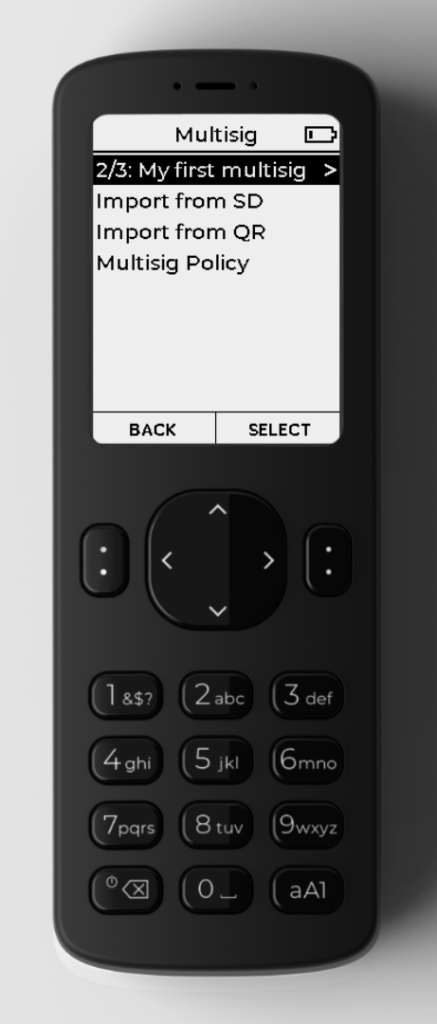
bitcoin Key storage
The Bitcoin network dictates that, to create a valid spend transaction, you must provide proof of ownership of the bitcoin being used in the transaction. This is done via the use of a private key to create a digital signature (or proof) that the person creating the transaction is spending the coins belonging to them. Anyone in the network can look at the provided signature and corresponding address being spent from to verify the authenticity of the transaction, without needing to know the private key of person creating the spend. Anyone with access to your private key can spend from your wallet. Now that we understand the importance of private keys, we should probably understand how to secure them properly!
A typical Bitcoin wallet, such as those found on a mobile phone or desktop applications, protects your sats with a single master secret or ‘key’. To sign off on any spend from such a wallet requires a signature from this single key. These types of wallets are colloquially referred to as ‘single-sig’, short for ‘single signature’, referring to the authentication level required to create a valid spend. Used in a setting such as a mobile phone, single-sig wallet setups provide great convenience for those on the go spends that are typically on the lower end of the value scale.
Single-sig wallets can of course be used in more secure setups, such as with an air-gapped hardware wallet like Passport. Used in this context, the key, which is required to authorize transactions, never leaves the offline device. When paired with wallet software like BlueWallet, the software manages incoming transactions and constructs outgoing spends for the offline device to read and sign using its stored key. This extra step, where the authority to spend has been removed from the ‘online’ wallet software, provides an extra security layer against potentially compromised internet connected devices.

With this simplicity comes a theoretical single point of failure. If your wallet and/or seed backup gets compromised, so does your bitcoin! Sure, you could deploy a Passphrase, but what if we wanted to take things a step further and protect ourselves against even more attack vectors?
What is multisig?
Much like single-sig, multisig (short for ‘multi signature’), derives its name from the level of authentication or ‘proof’ required to create a spend transaction. Generally speaking, a multisig wallet requires sign-off from more than one key for any spend. With multisig, you have the freedom to fine tune your wallet configuration to suit your personal circumstances. Two of the most common approaches taken today look like this:
A 2-of-3 setup where 3 keys are used to create the wallet and protect the bitcoin, but only 2 of those keys are required to authorize a spend
A 3-of-5 setup where 5 keys are used to create the wallet and protect the bitcoin, but only 3 of those keys are required to authorize a spend
The number of different Multisig configurations is almost limitless and can be tailored for almost any scenario. A company holding bitcoin on their balance sheet might opt to create an 7-of-12 setup where all board members hold a key and a majority (7) of them are required to authorize spends, whereas individuals would likely not require this level of complexity and would opt for a simpler setup with fewer keys to manage.

multisig benefits
So why might a sovereign individual want to consider a multisig setup? What extra benefits will be gained to offset the increased complexity?
- Removal of a single points of failure – In a single-sig setup, if the device holding your private keys, or the corresponding mnemonic seed backup is compromised, so is your bitcoin. With multisig, an attacker would need access to the multisig wallet (or backup file) AND the minimum number of keys required to make a spend.
- Redundancy – With a multisig wallet, you can afford to lose at least one key and its corresponding offline backup and still be able to spend your bitcoin. In a 2-of-3 setup, for example, loss of a single key would not result in a catastrophic loss of funds. Likewise, in a 3-of-5 setup, loss of two keys would not result in a loss of funds.
- Protection against a compromised manufacturer – In the unlikely event that the hardware wallet used in a single-sig setup turns out to contain a malicious back door, the wallet manufacturer could wait until funds are deposited and then drain the wallet at any point in the future. In this scenario, the manufacturer may not even be at fault; the device could be intercepted in-transit and swapped with a compromised device before arriving at its final destination. When a multisig wallet is configured with devices from multiple vendors, this attack is mitigated.
multisig considerations
While multisig offers exponentially improved protection from single points of failure and improved redundancy from key loss when compared to single-sig, it does also pose some new problems that must be considered before diving in head-first.
- More seeds to backup – Every device or key has its own mnemonic seed backup. Storing any of these at the same location negates the some of the benefits we outlined above. Do you have enough secure locations to store all of these seeds?
- More devices to secure – As outlined above, storing these devices in the same location is an attack vector. More devices = more secure locations required.
- Wallet configuration backup – In a doomsday scenario where a single key (and its backup) in a 2-of-3 setup is lost and the computer holding the wallet software is also not accessible, the remaining two keys, on their own, are not sufficient to recreate the wallet. To mitigate this, it is advisable to keep a copy of the wallet backup file with every key backup. Fortunately, modern multisig coordinator software like Sparrow or Specter Desktop offer this in a single file that can be printed or stored on a USB or microSD card. This file alone does not have the ability to spend; think of it as the ‘framework’ from which you can recreate the wallet.
- Inheritance – You might be an avid Bitcoiner, keen on leveling up your Bitcoin security but is your next of kin? You might have the most secure setup the world has ever witnessed, but if only you know how to access it, your bitcoin disappears when you do! The obvious thought is to leave some detailed instructions in case of emergency, but what if those instructions were to fall into the wrong hands?
- Spending inconvenience – If you need two keys to spend from your wallet, with one in your home and another a 90 minute drive away at a relative’s house, it could become a real chore if this is a wallet you’re planning to use on a regular basis.
multisig with passport
So, you’ve weighed up the pros and cons and decided to protect your bitcoin using a multisig wallet. Here’s one of the many ways you can do that easily using Passport and one of our favorite desktop wallets, Sparrow . Be sure to check out our other multisig tutorials covering BlueWallet and Specter Desktop.
Once set up, signing multisig transactions with Passport is very similar to single-sig and can be done via QR or microSD. Passport also allows you to view all of the multisig wallets it is a part of by heading to Settings > Multisig. Within the multisig menu you can also import new configurations via QR code or microSD as well as set the device’s ‘Multisig Policy‘. This setting dictates the way in which the device behaves when importing new configurations.



Multisig is an extremely powerful tool in the right hands, capable of protecting your wallet from almost all perceivable attack vectors – but it’s not without potential pitfalls! We suggest weighing the options discussed here and making up your own mind based on your own personal circumstances.